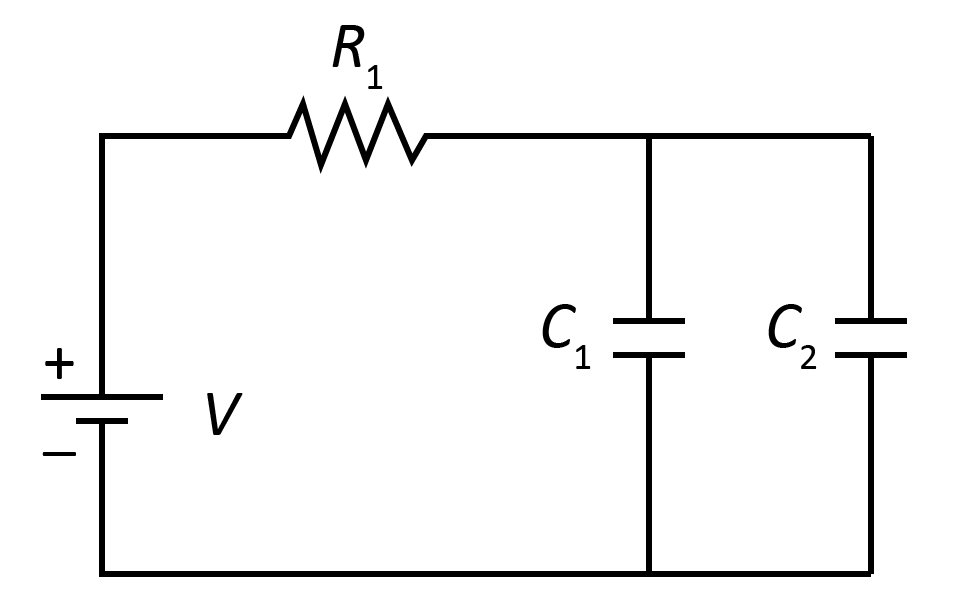
A circuit contains two capacitors in parallel wired in series to a resistor and source as shown above. The capacitors are initially uncharged. Which of the following describes the current I through and voltage

A) I=0 ,
B) I=0,
C) I=0,
D) I=V/R,
E) I=V/R,
Answer
142.8k+ views
Hint: Experimentally the time taken for a capacitor to get completely charged is equal to t=RC where t is the time constant in charging of the capacitor in C-R circuit, R is the resistance of the resistor in series and C is the capacitance of the capacitor. From this we can conclude that adding a resistance in series will increase the time taken by the capacitor to get fully charged.
Complete step by step answer:
A capacitor is a charge storing device. It is connected to a resistor initially and charged through a battery. The charging process is time dependent and it takes some time depending on the RC value of the circuit for the capacitor to reach maximum charge. But since we are leaving the capacitor connected for a long time, we assume that it is storing its maximum charge.
A capacitor connected across a DC supply keeps on charging till the potential across the battery becomes equal to the potential difference across the capacitor. In steady state after some time the current in the circuit will numerically be equal to zero. Hence we will use Kirchhoff’s law of voltage to see in steady state the potential difference across the capacitor.
Therefore, I=0,
Note: In an RC circuit, if the source is DC, the current then decreases from its initial value of I to zero as the voltage of the capacitor reaches the same value as the emf in case of transient period i.e. for a very short time in microseconds. As we know capacitors block the DC current, meaning the circuit will act as an open circuit.
Complete step by step answer:
A capacitor is a charge storing device. It is connected to a resistor initially and charged through a battery. The charging process is time dependent and it takes some time depending on the RC value of the circuit for the capacitor to reach maximum charge. But since we are leaving the capacitor connected for a long time, we assume that it is storing its maximum charge.
A capacitor connected across a DC supply keeps on charging till the potential across the battery becomes equal to the potential difference across the capacitor. In steady state after some time the current in the circuit will numerically be equal to zero. Hence we will use Kirchhoff’s law of voltage to see in steady state the potential difference across the capacitor.
Therefore, I=0,
Note: In an RC circuit, if the source is DC, the current then decreases from its initial value of I to zero as the voltage of the capacitor reaches the same value as the emf in case of transient period i.e. for a very short time in microseconds. As we know capacitors block the DC current, meaning the circuit will act as an open circuit.
Latest Vedantu courses for you
Grade 10 | MAHARASHTRABOARD | SCHOOL | English
Vedantu 10 Maharashtra Pro Lite (2025-26)
School Full course for MAHARASHTRABOARD students
₹33,300 per year
EMI starts from ₹2,775 per month
Recently Updated Pages
How to find Oxidation Number - Important Concepts for JEE

How Electromagnetic Waves are Formed - Important Concepts for JEE

Electrical Resistance - Important Concepts and Tips for JEE

Average Atomic Mass - Important Concepts and Tips for JEE

Chemical Equation - Important Concepts and Tips for JEE

Concept of CP and CV of Gas - Important Concepts and Tips for JEE

Trending doubts
JEE Main 2025 Session 2: Application Form (Out), Exam Dates (Released), Eligibility, & More

JEE Main Exam Marking Scheme: Detailed Breakdown of Marks and Negative Marking

JEE Main 2025: Derivation of Equation of Trajectory in Physics

Electric Field Due to Uniformly Charged Ring for JEE Main 2025 - Formula and Derivation

Electric field due to uniformly charged sphere class 12 physics JEE_Main

Degree of Dissociation and Its Formula With Solved Example for JEE

Other Pages
JEE Advanced Marks vs Ranks 2025: Understanding Category-wise Qualifying Marks and Previous Year Cut-offs

JEE Advanced 2025: Dates, Registration, Syllabus, Eligibility Criteria and More

JEE Advanced Weightage 2025 Chapter-Wise for Physics, Maths and Chemistry

Physics Average Value and RMS Value JEE Main 2025

Dual Nature of Radiation and Matter Class 12 Notes: CBSE Physics Chapter 11

Formula for number of images formed by two plane mirrors class 12 physics JEE_Main




